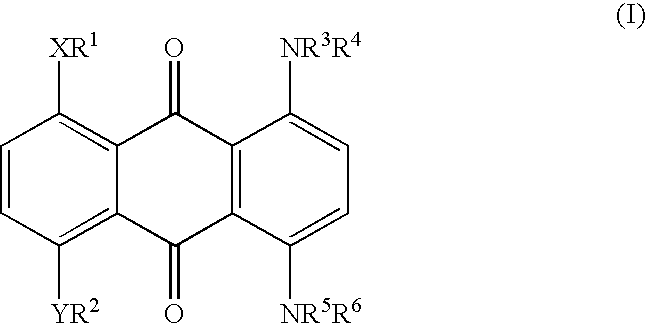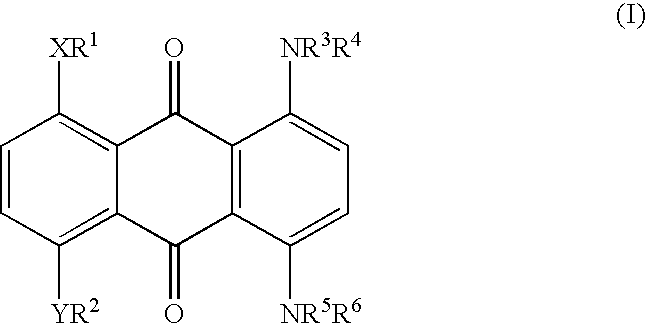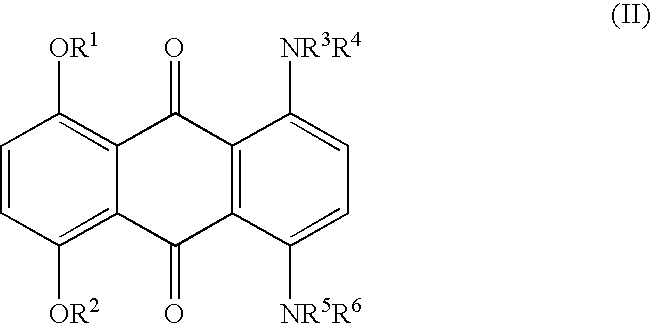Method for marking hydrocarbons with substituted anthraquinones
a technology of hydrocarbons and substituted anthraquinones, which is applied in the field of hydrocarbon marking with substituted anthraquinones, can solve the problems of difficult preparation or unstable, and achieve the effects of less costly, convenient quantitative spectrophotometric determination, and cost-effectiveness
- Summary
- Abstract
- Description
- Claims
- Application Information
AI Technical Summary
Benefits of technology
Problems solved by technology
Method used
Image
Examples
example 1
Synthesis of 1,4-di-(2-ethylhexylamino)-5,8-dihydroxyanthraquinone
[0036] A mixture of leuco-1,4,5,8-tetrahydroxyanthraquinone (5.91 g), sodium dithionite (1.09 g) and 1-hexanol (175.2 g) was stirred while adding 2-ethylhexylamine (24.08 g). The mixture was heated to reflux (148-152.degree. C.), maintained at reflux for 6-6.5 hours, and then cooled to ambient temperature. The precipitate was collected and washed thoroughly with methanol and water, and dried. The yield of dried isolated product was 7.0 g. Approximately another 1.9 g was present in the mother liquor, for a total yield of 8.9 g (90%). This material has a maximum absorption band (.lambda..sub.max) at a wavelength of 692 nm in xylene, or 688 nm in cyclohexane, with an extinction value of 0.640 AU in xylene and 0.660 AU in cyclohexane for a 10 mg / L solution. The solubility of the title compound in xylene is approximately 20%.
example 2
Synthesis of 1,4-di-(n-butylamino)-2,3-dicyanoanthraquinone
[0037] A mixture of 25.7 parts of Solvent Blue 35 {1,4-di-(n-butylamino)-a-nthraquinone}, 14.8 parts of NaCN, 10 parts of NH.sub.4HCO.sub.3, and 100 parts of dimethyl sulfoxide (DMSO) was allowed to react at 90-95.degree. C. for 6 hours to give 1,4-di-(n-butylamino)-2,3-dicyanoanthraquinone. This material has a maximum absorption band (.lambda..sub.max) at a wavelength of 700 nm in xylene with an extinction value of 0.23 AU for 10 mg / L.
example 3
Synthesis of 1,4,5,8-tetra-(4'-n-butylphenylamino)-2,3-dicyanoanthraquinon-e and 1,4,5,8-tetra(4'-n-butylphenylamino)-2,3,6,7-tetracyanoanthraquinone
[0038] A mixture of 8.0 parts of 1,4,5,8-tetra(4'-n-butylphenylamino)-anth-raquinone, 2.53 parts of NaCN, 1.65 parts of NH.sub.4HCO.sub.3, and 39 parts of DMSO was allowed to react at 90-95.degree. C. for 6 hours to give 1,4,5,8-tetra-(4'-n-butylphenylamino)-2,3-dicyanoanthraquinone. The structure of the di-cyano product was confirmed by proton and carbon-13 NMR. This material has a maximum absorption band (.lambda..sub.max) at a wavelength of 835 nm in xylene with an extinction value of 0.342 AU for 10 mg / L. Longer reaction time also gave rise to the 1,4,5,8-tetra(4'-n-butylphenylamino)-2,3,6,7-tetracyanoanthraquinone. The structure of the tetra-cyano product also was confirmed by proton and carbon-13 NMR. This material has a maximum absorption band (.lambda..sub.max) at a wavelength of 900 nm in xylene with an extinction value of 0.19...
PUM
| Property | Measurement | Unit |
|---|---|---|
| Fraction | aaaaa | aaaaa |
| Fraction | aaaaa | aaaaa |
| Electric charge | aaaaa | aaaaa |
Abstract
Description
Claims
Application Information
 Login to View More
Login to View More - R&D
- Intellectual Property
- Life Sciences
- Materials
- Tech Scout
- Unparalleled Data Quality
- Higher Quality Content
- 60% Fewer Hallucinations
Browse by: Latest US Patents, China's latest patents, Technical Efficacy Thesaurus, Application Domain, Technology Topic, Popular Technical Reports.
© 2025 PatSnap. All rights reserved.Legal|Privacy policy|Modern Slavery Act Transparency Statement|Sitemap|About US| Contact US: help@patsnap.com



